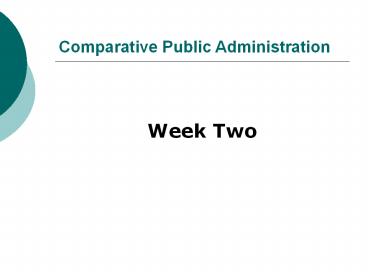Comparative Public Administration - PowerPoint PPT Presentation
Title:
Comparative Public Administration
Description:
The 'Five Minute' History or Understanding Max Weber. China- Mandarins- c. 1500 ... 476 AD Symbol: Taxes and Empire. a. Revenue- system for Tax ... Empire ... – PowerPoint PPT presentation
Number of Views:1333
Avg rating:3.0/5.0
Title: Comparative Public Administration
1
Comparative Public Administration
- Week Two
2
PIA 3090
- Comparative Public Management and Policy The
Concept
3
Presentation
- Golden Oldies
4
Origins of bureaucratic systems
- The Five Minute History or Understanding
Max Weber
5
China- Mandarins- c. 1500 BC Symbol Elites
- a. Personalized Despotism
- b. Ministries/Departments with Officials
- c. Hierarchy of Authority
- d. Selection based upon competition
- e. General administration model
6
Egypt- c. 1000 BC Symbol Technical achievement
- a. Clerks and Scribes
- b. Architects, engineers
- c. Pyramids- craftsmen as elites
- d. Contemporary views in Egypt Criticism
includes bribery, corruption, over-standardization
, red tape, extortion, laziness
7
Rome- 27 BC-476 AD Symbol Taxes and Empire
- a. Revenue- system for Tax collection
- b. Distinguish private vs. public
personalities of head of state/ separation of
resources of state from individuals - c. Distinguished ruler from ruled
- d. Contemporary critique Too large,
inflexible, oppressive, over-centralized
8
Feudalism- 400 AD-1400 AD Symbol Collapse
- a. Many power centers- myth of collapse
- b. Collapse of apparatus of central state-
not all bad - c. More developed state systems-Byzantium,
North Africa and Asia - d. Back to more traditionalist, fused systems
at the end of the period
9
African Kingdoms 800-1800
- Ghana- Hierarchical Monarchy
- Mali- Timbuktu and Higher Education
- Songhay- Imperial Grandeur
- Zimbabwe- Stone Architecture
- Zulu- Warfare and Totalitarianism
10
Absolutism and the Nation-State, 1500-1800
- a. Return to Roman Ideal
- b. Royal Privileges
- c. Raise revenues system of taxation, tax
collectors back in business - d. Mercentilism- wealth, based on state monopoly
companies, basis of state power. Empire key to
Expansion - e. Modern origins of specialized administration-
no longer members of the "king's household"-
11
Prussia Frederick the Great- 18th century
- a. Administration as a university study-
Cameralism (Chamber managing the public's
business) - b. Entrance Examinations
- c. Field Training (Internships)
- d. Critique caste status of bureaucrat, aloof,
exclusive and inflexible
12
India- Northcote-Trevelyn Report of 1854-BB
(Before Britain)
- a. Result of Indian Mutiny
- b. Pattern of Recruitment- Career appointments,
competitive examinations, and an end to patronage - c. Early model of merit system
13
8. Modern Europe- (Note John Armstrong)- England
- 1. Gentlemen generalists
- 2. Rotten boroughs and patronage
- 3. Sinecures- "bastard sons of the ruling
class - 4. Reform- merit, exams and elites
14
Continental Europe
- 1. France- Revolutionary model- routinization,
Technical specialization - 2. Iberia- Cartesian Models
- 3. Scandinavia/Benelux- Legal, then social model
15
Germany
- Prussia- law, authoritarian, hierarchical, and
the German Intellectual - Max Weber- Liberalism and the State- Influenced
by the Prussian model of the state
16
BREAK TIME
- TEN MINUTE BREAK
17
Max Weber 1864-1920
- Note It was history that influenced the ideas of
two late 19th century intellectuals, Karl Marx
and Max Weber - 1. Myth- Bureaucracy as a neutral actor
- 2. Max Webers Theory- Three ideal types of
administration- Max Weber's three models
18
Traditional- Fused
- 1. Looked back at China, Egypt, Rome and Africa
- 2. Fused System- magic, mystification and
witchcraft - 3. Key- gradual move to rational separation of
King from government
19
Charismatic- Revolutionary and the Aftermath of
French Revolution, 1789-1815
- 1. State identified with the movement and leader
- 2. Apex under Napoleon
- 3. Allegiance of civil servant to leader
20
Routinization of Charisma
- 4. Key Routinization of Charisma
- -from leader, shift loyalties one step further
to nation - -basic ministries- finance, foreign affairs,
War, Justice, Interior - 5. French revolution- Continued emphasis on
science and engineering
21
Legal-Rational Model
- Legal-Rational Model- Modern-specialized/technical
- Characteristics
- a. Merit Selection
- b. Hierarchy- Chain of Command
22
Legal-Rational Continued
- c. Division of Labor and functional
specialization - d. Administrative work full time, no sinecures
- e. Contractual agreement
- f. Professional or technical training
23
U.S.A.
- 1. Spoils, patronage and 1883 reforms. Selling
jobs - 2. Woodrow Wilson and Progressivism Babies and
Bathwater? - 3. Dichotomy- politics and administration
24
U.S.A. Continued
- 4. Popularized Max Weber's ideas
- 5. Keynesianism and Good Government
- 6. Privatization, Free Trade and Small
Government
25
Issues Thus Far
- 1. Defining Comparative Methodology, Theory,
Case Study analysis (David Truman) - 2. Public Administration vs. Public Policy and
Management (administration vs. Politics
dichotomy) (Ferrel Heady)
26
This Far, Continued
- 3. Debates about Historical Epochs Relevance
to 21st century problems (James C. Scott and John
Armstrong) - 4. Debate about Culture (Michel Crozier and
Robert Klitgaard) - 5. Debates about Bureaucrat Bashing ( Lynn and
Jay and Franz Kafka as the Master)
27
Mock Question of the Week
- "He knew something about human nature all
right...It was, perhaps, a knowledge not of human
nature in particular but his own nature in
particular...In a way, he flattered human
nature.1 Discuss. To what extent are human
and social characteristics the key to
understanding comparative public administration
issues? - 1 Robert Penn Warren, All the Kings Men (New
York Harcourt Brace, 1946), p. 74.































